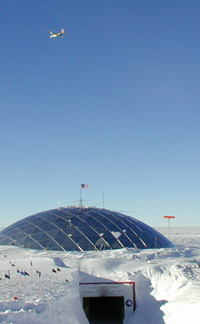|
Cold,
clear, and quiet:
|

|
|
|
|
|
|
|

|

|
|
|
Click
to explore a panorama
.
|
|
Into
the white at the South Pole.
by Noel Wanner
January
1, 2001
When
the motors fall silent, the silence rushes in from the flat
horizon and hits you like a wall-- the silence of thousands
of miles of empty ice, a frozen desert on an ice plateau two
miles deep.
We've
come to explore the life and science at the South Pole, at
Amundsen-Scott Station. Around us, the construction crews
work at a fevered pace, building the new South Pole Station,
but the bustle of the cranes and bulldozers seems somehow
just a desperate attempt to keep the silence back. And when
the shift is over, everyone hurries indoors for warmth, and
the comfort of human voice, of four walls limiting that deep
horizon.
|
|

|
|

|
A
C-130 passes away high above the
dome
of the South Pole Station.
|

|
|
|
|

|
The
people who live and work at the South Pole deal with one of
the harshest environments on earth. The average temperature
is about -50 degrees, and during the months-long winter, temperatures
can drop to 100 below zero. The air is too cold to hold any
moisture-- it dries your sinuses until they bleed. Nothing
lives here, except humans, in a tiny community ranging from
220 summer inhabitants to 45 hardy souls over the winter.
This community and its work are sustained through a massive
logistical effort, including several LC-130 flights each day,
bringing food, fuel, scientific equipment, and construction
materials, and taking away waste and Pole workers headed home.
The comfort that exists here is entirely dependent on this
supply chain-- without it, silence and cold would soon return
to empty this place. That this community persists is nearly
miraculous, a testament to the will humans have to explore.
Scientists
make use of this silence, this last most clear and empty space:
astronomers point telescopes at the thin sky, strange kaleidoscope
eyes sorting the spectra of the cosmic background radiation,
hunting for the faint traces of the birth of our universe.
Some drill down to place seismographs, listening for earthquakes
and nuclear tests around the world.
|
